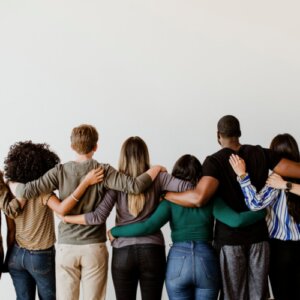Human Universals: Donald E. Brown


Reviewed and approved by the psychologist Sergio De Dios González
Human universals are a hot topic of debate, particularly in sociology and anthropology. They start from the question of whether there are elements that form part of the human essence, regardless of upbringing or culture. In this regard, thinkers such as Emile Durkheim, George Murdock, Claude Lévi-Strauss, and Donald E. Brown have spoken. These figures all believe that there are universals or patterns common to the entire species, which are evolutionarily determined.
On the other hand, some philosophers adopt a different approach. It’s known as cultural relativism. According to this viewpoint, there are no human universals, but everything is determined and shaped by the environment. Ultimately, it’s the age-old debate of nature versus nurture.
“We are not blank slates.”
-Steven Pinker-
Donald E. Brown and human universals
Donald E. Brown is an American anthropologist who attempted to complete a list of human universals. In other words, an inventory of essential attributes that are present in all human beings, regardless of what culture they belong to.
Brown claims that there are no exceptions to these universals. On this basis, he designed his famous list that has been taken up by other highly regarded theorists such as Steven Pinker. The list, which consists of several hundred human universals includes the following:
Language and cognition
- Planning.
- Taboo expressions.
- Units of time.
- Synesthetic metaphors.
- Antonyms and synonyms.
- Translatable language.
- Figurative speech and metaphors.
- Symbolism and symbolic discourse.
- Binary cognitive distinctions.
- Color terms. Eg. black and white.
- Series (ordered cognitive patterns).
- Abstraction in speech and thought.
- Language for manipulating others.
- Special speech for special occasions.
- Language employed to manipulate, misinform or mislead.
- Discrepancies between speech, thought, and action.
- Reward for proficient use of language (eg, poetry).
- Logical notions of ‘and’, ‘not’, ‘opposite’, ‘equivalent’, ‘part/whole’, and ‘general/particular’.
- Age classification, behavioral propensities, body parts, colors, fauna, flora, internal states, kinship, sex, space, tools, and weather conditions.

Society
- Leaders.
- Labels.
- Conflict.
- Trade.
- Property.
- Compassion.
- Coalitions.
- Marriage.
- Visiting others.
- Sexual jealousy
- States and roles.
- Territoriality.
- Family or home.
- Gender roles.
- Sexual violence.
- Age grades/states/terms.
- Inheritance rules.
- Oligarchy (de facto).
- Teamwork.
- Promises/oaths.
- Moral sentiments.
- Kin groups.
- Identity, collective.
- Affection is expressed and felt.
- Prestige inequalities.
- Collective decision making.
- Redress of wrongs.
- Some forms of proscribed violence.
- Husband older than wife on average.
- Individual names for people.
- Groups that aren’t based on family.
- Law: Rights/obligations. Rules/ memberships.
- Copulation is normally conducted in privacy.
- Generosity admired.
- Distinguishing right and wrong.
- Incest prevention or avoidance. Incest between mother and child is taboo.
- Mood or consciousness-altering substances and/or techniques.
- Males, on average, travel greater distances over their lifetimes.
- Actions under self-control are distinguished from those not under control.
- Triangular awareness (assessing relationships among the self and two other people).
Beliefs
- Art.
- Feasting.
- Hairstyles
- Play.
- Future. Attempts to predict.
- Rites of passage.
- Body adornment.
- Proverbs, sayings.
- Magic.
- Childbirth customs.
- Narrative.
- Dream interpretation.
- Poetry/rhetoric.
- Beliefs about death.
- Death rituals.
- Healing the sick (or attempting to).
- Weather control (attempts to).
- Beliefs about disease.
- Beliefs about fortune and misfortune.
- Magic to increase life/ sustain life/win love.
- Music. (Seen as art. Related to religious activity/dance. Children’s/vocal).
- Rhythm.
Technology
- Weapons.
- Cooking.
- Shelter.
- Lever.
- Intertwining (eg. weaving).
- Containers.
- Fire.
- Tools and tool making.

Stances toward Brown’s human universals
The fact that Donald Brown constructed a list of human universals and that many scholars have verified that, indeed, they’re elements that do appear in all cultures, doesn’t mean that his theory is accepted by everyone.
In fact, some anthropologists think that they’re due to coincidence. They believe that, in different places and cultures, people experience similar problems. As human beings, they possess similar capacities and may find similar solutions. However, this doesn’t mean that they’re human universals.
Furthermore, it’s not possible to establish to what extent some cultures have influenced others. In other words, it can’t be affirmed to what degree certain cultures have developed solutions or products that others later imitate and assimilate. For this reason, the discussion on human universals remains open to debate.
Human universals are a hot topic of debate, particularly in sociology and anthropology. They start from the question of whether there are elements that form part of the human essence, regardless of upbringing or culture. In this regard, thinkers such as Emile Durkheim, George Murdock, Claude Lévi-Strauss, and Donald E. Brown have spoken. These figures all believe that there are universals or patterns common to the entire species, which are evolutionarily determined.
On the other hand, some philosophers adopt a different approach. It’s known as cultural relativism. According to this viewpoint, there are no human universals, but everything is determined and shaped by the environment. Ultimately, it’s the age-old debate of nature versus nurture.
“We are not blank slates.”
-Steven Pinker-
Donald E. Brown and human universals
Donald E. Brown is an American anthropologist who attempted to complete a list of human universals. In other words, an inventory of essential attributes that are present in all human beings, regardless of what culture they belong to.
Brown claims that there are no exceptions to these universals. On this basis, he designed his famous list that has been taken up by other highly regarded theorists such as Steven Pinker. The list, which consists of several hundred human universals includes the following:
Language and cognition
- Planning.
- Taboo expressions.
- Units of time.
- Synesthetic metaphors.
- Antonyms and synonyms.
- Translatable language.
- Figurative speech and metaphors.
- Symbolism and symbolic discourse.
- Binary cognitive distinctions.
- Color terms. Eg. black and white.
- Series (ordered cognitive patterns).
- Abstraction in speech and thought.
- Language for manipulating others.
- Special speech for special occasions.
- Language employed to manipulate, misinform or mislead.
- Discrepancies between speech, thought, and action.
- Reward for proficient use of language (eg, poetry).
- Logical notions of ‘and’, ‘not’, ‘opposite’, ‘equivalent’, ‘part/whole’, and ‘general/particular’.
- Age classification, behavioral propensities, body parts, colors, fauna, flora, internal states, kinship, sex, space, tools, and weather conditions.

Society
- Leaders.
- Labels.
- Conflict.
- Trade.
- Property.
- Compassion.
- Coalitions.
- Marriage.
- Visiting others.
- Sexual jealousy
- States and roles.
- Territoriality.
- Family or home.
- Gender roles.
- Sexual violence.
- Age grades/states/terms.
- Inheritance rules.
- Oligarchy (de facto).
- Teamwork.
- Promises/oaths.
- Moral sentiments.
- Kin groups.
- Identity, collective.
- Affection is expressed and felt.
- Prestige inequalities.
- Collective decision making.
- Redress of wrongs.
- Some forms of proscribed violence.
- Husband older than wife on average.
- Individual names for people.
- Groups that aren’t based on family.
- Law: Rights/obligations. Rules/ memberships.
- Copulation is normally conducted in privacy.
- Generosity admired.
- Distinguishing right and wrong.
- Incest prevention or avoidance. Incest between mother and child is taboo.
- Mood or consciousness-altering substances and/or techniques.
- Males, on average, travel greater distances over their lifetimes.
- Actions under self-control are distinguished from those not under control.
- Triangular awareness (assessing relationships among the self and two other people).
Beliefs
- Art.
- Feasting.
- Hairstyles
- Play.
- Future. Attempts to predict.
- Rites of passage.
- Body adornment.
- Proverbs, sayings.
- Magic.
- Childbirth customs.
- Narrative.
- Dream interpretation.
- Poetry/rhetoric.
- Beliefs about death.
- Death rituals.
- Healing the sick (or attempting to).
- Weather control (attempts to).
- Beliefs about disease.
- Beliefs about fortune and misfortune.
- Magic to increase life/ sustain life/win love.
- Music. (Seen as art. Related to religious activity/dance. Children’s/vocal).
- Rhythm.
Technology
- Weapons.
- Cooking.
- Shelter.
- Lever.
- Intertwining (eg. weaving).
- Containers.
- Fire.
- Tools and tool making.

Stances toward Brown’s human universals
The fact that Donald Brown constructed a list of human universals and that many scholars have verified that, indeed, they’re elements that do appear in all cultures, doesn’t mean that his theory is accepted by everyone.
In fact, some anthropologists think that they’re due to coincidence. They believe that, in different places and cultures, people experience similar problems. As human beings, they possess similar capacities and may find similar solutions. However, this doesn’t mean that they’re human universals.
Furthermore, it’s not possible to establish to what extent some cultures have influenced others. In other words, it can’t be affirmed to what degree certain cultures have developed solutions or products that others later imitate and assimilate. For this reason, the discussion on human universals remains open to debate.
All cited sources were thoroughly reviewed by our team to ensure their quality, reliability, currency, and validity. The bibliography of this article was considered reliable and of academic or scientific accuracy.
- Bokser, J., Salas-Porras, A. (2007). Globalización, identidades colectivas y ciudadanía. Nacionalismo e identidades culturales, 12(2999). https://polcul.xoc.uam.mx/index.php/polcul/article/view/224
- Corazón, R. (2004). Sobre la esencia humana. Algunas consideraciones sobre Antropología trascendental II. La esencia de la persona humana, de Leonardo Polo. Studia Poliana, 6, 211-223. https://dadun.unav.edu/handle/10171/8771
- Larreta Zulategui, J. P. (2009). Eufemismos y tabúes lingüísticos en la fraseología alemana. Magazin, (1), 56–61. https://doi.org/10.12795/mAGAzin.1996.i01.05
This text is provided for informational purposes only and does not replace consultation with a professional. If in doubt, consult your specialist.







